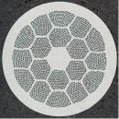WB-7-1-INV
Bi-2212 Magnet Technology, Progress and Challenges
09:00-09:30 30/11/2023
*U.P. Trociewitz, D.S. Davis, Y. Kim, C.L. English, J. Kvitkovic, E.E. Hellstrom, J. Jiang, F. Kametani, E. Martin, G. Bradford, S. Barua, G. Miller, J. Lu, V. Griffin, P. Lee, L.D. Cooley, D.C. Larbalestier
Applied Superconductivity Center/National High Magnetic Field Laboratory, 2031 E Paul Dirac Dr, Tallahassee, FL 32310, USA
Round wire Bi-2212 magnet technology is steadily making its ways into various areas of high field magnet applications like general high-field, accelerator, and fusion magnets. On the conductor level, consistent performance of production lengths >1km can now be obtained. The heat treatment process, which is a particularity when working with Bi-2212 conductor, provides consistent and reproducible results. Partnering with two magnet industry leaders, we are moving towards building high field inserts with the ultimate goal of reaching high field homogeneity, field stability and reliable performance in the >30 T field range. Besides improved conductor performance we are developing expertise in the high field magnet manufacturing processes that involve the identification and testing of suitable materials for electric insulation and mechanical reinforcement on the conductor and coil level. Postmortems on coils provide essential information on how these components perform in a winding pack during high field operation and provide us with means to improve our magnet modeling efforts. A recent test of a set of high field coils generating a combined, stable field of 34.1 T at ramp rates of up to 3200 A/s without performance degradation clearly shows the capability and robustness of Bi-2212 for high field magnet technology. With a focus on accelerator and fusion magnet technology we are continuing to work on Rutherford cable technology. Coils made with Rutherford cables show very good promise with some manufacturing issues currently being addressed. A key to a successful Bi-2212 coil technology are our two high pressure furnaces that are used to heat treat all our coils as well as those of our collaborators from industry and those within the US magnet development program (MDP). This presentation will provide an overview of our Bi-2212 coil program and its progress.
This work is supported by the US DOE Office of High Energy Physics under grant number DE-SC0010421 and DE-SC0018683, and by the National Science Foundation under NSF/DMR-1644779 and by the State of Florida. Collaborations within the US Magnet Development Program supported by DOE-OHEP, especially with LBNL are gratefully acknowledged.
